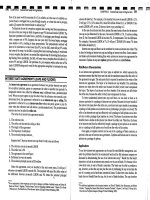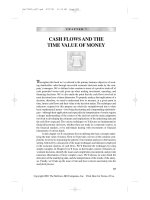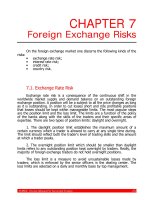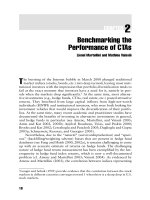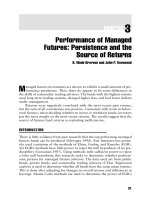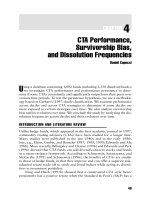Commodity Trading Advisors: Risk, Performance Analysis, and Selection Chapter 7 docx
Bạn đang xem bản rút gọn của tài liệu. Xem và tải ngay bản đầy đủ của tài liệu tại đây (213.45 KB, 19 trang )
CHAPTER
7
Simple and Cross-Efficiency
of CTAs Using Data
Envelopment Analysis
Fernando Diz, Greg N. Gregoriou, Fabrice Rouah,
and Stephen E. Satchell
W
e apply data envelopment analysis and use the basic and cross-
efficiency models to evaluate the performance of CTA classifications.
With the ever-increasing number of CTAs, there is an urgency to provide
money managers, institutional investors, and high-net-worth individuals
with a trustworthy appraisal method for ranking their efficiency. Data
envelopment analysis can achieve this, eliminating the need for bench-
marks, thereby alleviating the problem of using traditional benchmarks to
examine nonnormal returns. This chapter studies CTAs and identifies the
ones that have achieved superior performance or have an efficiency score of
100 in a risk/return setting.
INTRODUCTION
Research into the performance persistence of commodity trading advisors
(CTAs) is sparse, so there is little information on the long-term diligence of
these managers (see, e.g., Edwards and Ma 1988; Irwin, Krukemeyer, and
Zulaf 1992; Irwin, Zulauf, and Ward 1994; Kazemi 1996). It is generally
agreed that during bear markets, CTAs provide greater downside protection
than hedge funds and have higher returns along with an inverse correlation
to equities. The benefits of CTAs are similar to those of hedge funds, in that
they improve and may offer a superior risk-adjusted return trade-off to
stock and bond indices and can act as diversifiers in investment portfolios
(Schneeweis, Savanayana, and McCarthy 1991; Schneeweis, 1996).
129
c07_gregoriou.qxd 7/27/04 11:11 AM Page 129
Investors who have chosen to include CTAs in their portfolios have
allocated only a small portion of their assets. This can be attributed to the
mediocre performance of CTAs during the early 1990s (Georgiev 2001).
Others are unaware that during periods of increased stock market volatil-
ity, careful inclusion of CTA managers into investment portfolios can
enhance their returns especially during severe bear markets (Schneeweis and
Georgiev 2002). Moreover, extreme volatility in international financial
markets of this past decade, such as that experienced during the Asian cur-
rency crisis of 1997 and the Russian ruble crisis of August 1998, did not
significantly affect CTA performance. In fact, during these periods of high
volatility, CTAs make most of their money and produce superior returns
relative to traditional market indices.
Much recent debate has centered on how to measure and evaluate the
performance of CTAs. Comparing CTAs to standard market indices could be
erroneous since CTAs are viewed as an alternative asset class and possess dif-
ferent characteristics from traditional stock and bond portfolios. Unlike
mutual funds, it is difficult to identify factors that drive CTA returns
(Schneeweis, Spurgin, and Potter 1996). Fung and Hsieh (1997b) apply
Sharpe’s factor “style” analysis to CTAs and find that very little of the vari-
ability in CTA returns can be attributed to variability of financial asset
classes (in marked contrast to what Sharpe (1992) finds for mutual funds).
They attribute the low R-squared values to the dynamic strategies of CTAs.
Investors and analysts placing too much faith in these models are therefore
at risk of being misled by biased alphas (Schneeweis, Spurgin, and McCarthy
1996). The underlying question of which benchmarks would be appropriate
for each CTA strategy continues to be a controversial one.
How performance is measured also can be the reason for divergent
results. Excess returns can display performance persistence when in fact it
is nonexistent. A recent study by Kat and Menexe (2002) suggests that the
predictability in returns is low.
The nonnormal returns that CTAs often display make it difficult to
apply linear factor models that use traditional market indices since these do
not offer a sufficient measure of CTA risk exposure. Fung and Hsieh
(1997b) argue that the explanatory power of these models is weak and pro-
pose an extension of Sharpe’s model to CTAs whereby specific CTA
“styles” are defined. The traditional Sharpe ratio usually overestimates and
miscalculates nonnormal performance, because this well-known risk-
adjusted measure does not consider negative skewness and excess kurtosis
(Brooks and Kat 2001).
Using CTA indices to examine performance persistence also can intro-
duce biases. CTA indices are rebalanced and cannot properly reproduce the
130 PERFORMANCE
c07_gregoriou.qxd 7/27/04 11:11 AM Page 130
same composition during an entire examination period; consequently per-
sistence could be wrongly estimated.
Regardless of the capability of existing and frequently used models to
explain CTA returns, the dynamic trading strategies and skewed returns
remain critical issues in the CTA performance literature, and further inves-
tigation is warranted.
We use simple and cross-efficiency DEA models to handle the problems
encountered when using multifactor models to predict CTA returns. DEA
allows us to appraise and rank CTAs in a risk-return framework without
using indices. The efficient frontier is generated from the most efficient
CTAs, and DEA calculates the efficiency of each CTA relative to the effi-
cient frontier, thereby producing an efficiency score according to the input
and output variables used. The selection of variables is discussed in the
methodology and data section. DEA is a nonparametric technique that
measures the relative efficiency of decision-making units (DMUs) on the
basis of observed data and then presents an efficiency score as a single num-
ber between 0 and 100.
1
The main benefit of DEA is that it identifies the
best-performing CTA and determines the relative efficiencies of a set of sim-
ilar CTAs (peers). DEA, also called frontier analysis, was originally devel-
oped by Charnes, Cooper, and Rhodes (CCR) (1978). It was later adapted
by Banker, Charnes, and Cooper (BCC) (1984), who expanded the Farrell
(1957) technical measure of efficiency from a single-input, single-output
process to a multiple-input, multiple-output process. The CCR and BCC
models are the simple (or basic) DEA models and were developed originally
for nonprofit organizations. Later we discuss an alternative DEA model:
cross-efficiency.
The power of DEA is in its ability to deal with several inputs and out-
puts while not requiring a precise relation between input and output vari-
ables. DEA produces an efficiency score which takes into account multiple
inputs and outputs, and uses the CTAs themselves as the benchmark. Using
an alternative performance measure like DEA is beneficial because it
enables investors to potentially pinpoint the reasons behind a CTA’s poor
performance. Once the weaknesses are recognized, the CTA can attempt to
reach a perfect efficiency score by comparing itself to CTAs that have
achieved an efficiency score of 100. Furthermore, numerous DEA software
programs, such as the DEA solver in Zhu (2003), and Banxia’s Frontier
Simple and Cross-Efficiency of CTAs Using Data Envelopment Analysis 131
1
An efficiency score of 100 refers to an efficient fund (or best-performing fund that
lies on the frontier); a score of less than 100 signifies the fund is inefficient.
c07_gregoriou.qxd 7/27/04 11:11 AM Page 131
Analyst, provide an improvement summary that can pinpoint the weak-
nesses from the CTA’s inputs and outputs.
For institutional investors considering using CTAs as downside protec-
tion in bear markets, it is critical that a performance measure provide not
only a precise appraisal of the CTA’s performance, but also an idea of the
quality of its management with respect to certain criteria (variables such as
inputs and outputs). Using DEA could present investors with a useful tool
for ranking CTAs, not by historical returns, but by peer group appraisal.
In the next section we discuss the different DEA methodologies. Then
we describe the data, discuss the empirical results, and summarize our
conclusions.
METHODOLOGY
In its most rudimentary form, DEA calculates an efficiency score that
describes the relative efficiency of a CTA when compared to other CTAs in
the sample. The first step in DEA is to obtain an efficient frontier from the
inputs and outputs identified by Pareto optimality.
2
DEA then calculates the
efficiency score of each DMU relative to the efficiency frontier. In this chap-
ter, the DMUs are CTAs.
The efficiency frontier consists of the “best-performing” CTAs—the
most efficient at transforming the inputs into outputs (Charnes, Cooper, and
Rhodes, 1981). Any CTA not on the frontier would have an efficiency score
less than 100 and would be labeled inefficient. For example, a CTA with an
efficiency score of 80 is only 80 percent as efficient as the top-performing
CTA. A best-performance frontier charts the maximum or minimum level of
output (input) produced for any assumed level of input (output), where out-
puts represent the degree to which the CTA’s goal has been achieved.
How the inputs and outputs are used in the efficiency analysis are
essential because they establish the grounds on which the efficiency of the
fund is calculated. The most extensively used DEA technique to measure
efficiency takes the weighted sum of outputs and divides it by the weighted
sum of inputs (Golany and Roll, 1994). In its simplest form, DEA calculates
weights from a linear program that maximizes relative efficiency with a set
132 PERFORMANCE
2
Pareto optimality means the best that can be attained without putting any group at
a disadvantage. In other words, a group of funds becomes better off if an individual
fund becomes better off and none becomes worse off.
c07_gregoriou.qxd 7/27/04 11:11 AM Page 132
of minimal weight constraints.
3
Charnes, Cooper, and Rhodes (1978) pro-
posed reducing the multiple-input, multiple-output model to a ratio with a
single virtual input and a single virtual output.
Simple Efficiency
The main distinction between the two simple DEA models is that the BCC
model uses varying returns to scale to examine the relative efficiency of
CTAs, while the CCR model uses constant returns to scale.
4
To obtain
robust results, a proper working sample ought to be on the order of three
times the number of CTAs as the number of input and output variables
(Charnes, Cooper, and Rhodes, 1981). In addition, DEA uses a compara-
tive measure of relative performance framework.
We adapt the notation from Adler, Friedman, and Stern (2002) for the
simple and cross-efficiency models. By comparing n CTAs with s outputs,
denoted by y
rk
in equation 7.1, where r =1, , s, and m inputs denoted
by x
ik
, i =1, , m, the efficiency measure for fund k is:
(7.1)
where the weights u
r
and v
i
are positive. An additional set of constraints
requires that the same weights, when applied to all CTAs, not allow any
CTA with an efficiency score greater than 100 percent and is displayed in
this set of constraints:
uy
vx
jn
rrj
r
s
iij
i
m
=
=
∑
∑
≤=
1
1
11for , , .
hMax
uy
vx
k
rrk
r
s
iik
i
m
=
=
=
∑
∑
1
1
Simple and Cross-Efficiency of CTAs Using Data Envelopment Analysis 133
3
Linear programming is the optimization of a multivariable objective function, sub-
ject to constraints.
4
The BCC model permits a greater number of potential optimal solutions. With the
BCC model, the number of funds with an efficiency score of 100 will, on average,
be higher than with the CCR model. Choosing between these models requires
insight into what the process will involve. For example, if the increase in inputs does
not provide the same increase in outputs, then the variable returns to scale model
should be used.
c07_gregoriou.qxd 7/27/04 11:11 AM Page 133
The efficiency score falls between 0 and 100, with CTA k regarded as
efficient on receiving an efficiency score of 100. Therefore, each CTA selects
weights to maximize its own efficiency.
subject to the constraints:
(7.2)
u
r
≥ 0 for r = 1, ,s,
v
i
≥ 0 for i = 1, ,m.
An extra constant variable, denoted by c
k
, is added in the BCC model
to allow variable returns to scale between inputs and outputs. For a CTA to
be BCC technically efficient; its only requirement is to be efficient; for a
CTA to be efficient in the CCR model, it must be both scale and technically
efficient (Bowlin 1998).
A CTA is considered scale efficient if the level of its operation is opti-
mal. If the scale efficiency is reduced or increased, the efficiency will
weaken. A scale-efficient CTA will function at most favorable returns to
scale. In essence, the distance on a production frontier between the constant
returns to scale and the variable returns to scale frontier establishes the
component labeled scale efficiency. A CTA is considered technically efficient
if it is able to maximize each of its outputs per unit of input, thus signify-
ing the efficiency of the conversion process of the variables. In this chapter
technical efficiency is calculated using the BCC model.
In a production frontier, constant returns to scale implies that any
increase in the inputs of a CTA will result in a proportional increase in its
outputs. In other words, a linear relationship would be present between
inputs and outputs. If a CTA were to increase its inputs by 5 percent,
thereby producing a similar increase in outputs, the CTA would be operat-
ing at constant returns to scale. Consequently, irrespective of what scale the
CTA operates at, its efficiency will stay the same.
If an increase in the inputs of a CTA does not induce a proportional
transformation in its outputs, however, then the CTA will display variable
vx
i
i
m
ik
=
∑
=
1
1,
vx uy c j n
i
i
m
ij r rj
r
s
k
==
∑∑
−−≥=
11
01for , ,
h Max u y c
krrk
r
s
k
=+
=
∑
1
134 PERFORMANCE
c07_gregoriou.qxd 7/27/04 11:11 AM Page 134
returns to scale, which implies that as the CTA alters its level of day-to-day
operations, its efficiency can increase or decrease. Therefore, since CTAs
vary their leverage at different times to magnify returns, we employ the
BCC model (varying returns to scale).
Cross-Efficiency
The cross-evaluation, or cross-efficiency, model was first seen in Sexton,
Silkman, and Hogan (1986) and later in Oral, Ketani, and Lang (1991),
Doyle and Green (1994), and Thanassoulis, Boussofiane, and Dyson (1995).
It establishes the ranking procedure and computes the efficiency score of
each CTA n times using optimal weights measured by the linear programs.
A cross-evaluation matrix is a square matrix of dimension equal to the
number of CTAs in the analysis. The efficiency of CTA j is computed with
the optimal weights for CTA k. The higher the values in column k, the more
likely that CTA k is efficient using superior operating techniques. Therefore,
calculating the mean of each column will provide the peer appraisal score
of each CTA. The cross-efficiency method is superior to the simple effi-
ciency method because the former uses internally generated weights as
opposed to forcing predetermined weights.
The cross-evaluation model used here is represented by equation 7.3:
(7.3)
where h
kj
= score of CTA j cross-evaluated by the weight of CTA k.
In the cross-evaluation matrix, all CTAs are bounded by 0 ≤ h
kj
≤ 1, and
the CTAs in the diagonal, h
kk
, represent the simple DEA efficiency score, so
that h
kk
= 1 for efficient CTAs and h
kk
< 1 for inefficient CTAs. Equation
7.3 shows that the problem of trying to distinguish the relative efficiency
scores of all CTAs is generated n times.
The DEA method renders an ex-post evaluation of a CTA’s efficiency
and specifies the precise input-output relation. The relation must be realized
without a level of efficiency greater than 100 when the coefficients are
adapted to the CTAs in our sample. Efficiency scores, as they are relative to
the other CTAs in the sample, are by no means absolute.
Papers on DEA have been published in many sectors, and the use of
such analysis often has resulted in technical and efficiency improvements.
DEA also has been used recently to evaluate the performance of mutual
h
uy
vx
knjn
kj
rk rj
r
s
ik ij
i
m
===
=
=
∑
∑
1
1
11, , , , , , ,
Simple and Cross-Efficiency of CTAs Using Data Envelopment Analysis 135
c07_gregoriou.qxd 7/27/04 11:11 AM Page 135
funds and determine the most efficient funds (see, e.g., McMullen and
Strong 1997; Bowlin 1998; Morey and Morey 1999; Sedzro and Sardano
2000; Basso and Funari 2001). Barr, Seiford, and Siems (1994), however,
suggest that using a single input/output ratio to assess management quality
is impractical; instead they propose a multidimensional approach.
However, the CCR model is one of the first DEA models based on effi-
ciency. It allows a set of optimal weights to be calculated for each input and
output to maximize a CTA’s efficiency score. If these weights were applied
to any other fund in our database, the efficiency score would not exceed
100. The CCR score aggregates technical and scale efficiency. Despite the
many modified DEA models in existence, the CCR model is the most
broadly known and used. Basically, the BCC and CCR models offer two
ways of considering the same problem.
As we noted earlier, cross-evaluation DEA is superior to either simple
DEA method because efficiency is still measured relative to the CTA with
the highest efficiency score, but having more than one combination of
weights of a fund that maximizes its own efficiency adds an extra dimen-
sion of flexibility. The main idea of DEA is that it is flexible and can branch
out to other CTAs to evaluate their individual performance. CTAs with high
average efficiency from a cross-efficiency matrix can be considered as good
examples for inefficient CTAs to work toward and improve their methods.
We adopt and expand the methodology of Sedzro and Sardano (2000),
who investigated mutual funds, and apply it to CTA classifications. Since
CTAs exhibit nonnormal distribution of returns and display fat tails, we use
variables different from those used for mutual funds (Fung and Hsieh
1997a). In previous studies skewness was shown to have an influence on
monthly average returns in stock markets (see Sengupta 1989).
The inputs and outputs must correspond to the activities of CTAs for
the analysis to make sense. We use six variables in a risk-return framework,
three for inputs and three for outputs, because a larger number might clut-
ter the analysis. Three times the number of inputs and outputs will result in
having sufficient observations (degrees of freedom) to get a good evalua-
tion. Having a greater number of variables could result in an overlap of
measuring inputs and outputs, thereby producing some problems in inter-
preting the results. If too many variables are used, the analysis could result
in many CTAs being rated efficient.
Modern portfolio theory measures the total risk of a portfolio by using
the variance of the returns. But this method does not separate upside risk,
which investors seek, from the downside returns they want to avoid. Vari-
ance is not usually a good method for measuring risk, but semivariance is
generally accepted and frequently used because it measures downside risk.
Returns above the mean can hardly be regarded as risky, but variance below
the mean provides more information during extreme market events. This is
136 PERFORMANCE
c07_gregoriou.qxd 7/27/04 11:11 AM Page 136
important for investors who worry more about underperformance than
overperformance (Markowitz 1991).
5
Because CTAs can obtain positive
returns in flat or down markets, they induce negative skewness in portfolio
return. Adding CTAs to a traditional stock and bond portfolio to obtain
higher risk-adjusted returns and lower volatility will therefore result in a
trade-off between negative skewness and diversification of the portfolio
(Diz 1999).
The mean and standard deviations of CTA returns can be misleading;
examining higher moments such as skewness is recommended (Fung and
Hsieh 1997a). The introduction of skewness in inputs and outputs might
present some signaling assessment of each CTA classification because skew-
ness does not penalize CTA by the upside potential returns. Although CTAs
attempt to maximize returns and minimize risk, this comes at a trade-off;
adding CTAs to traditional investment portfolios will likely result in high
kurtosis and increased negative skewness, which are the drawbacks of this
alternative asset class.
DATA
We use CTA data from the Barclay Trading Group/Burlington Hall Asset
Management and examine five CTA classifications during the periods from
1998 to 2002 and 2000 to 2002. The subtype CTA classifications include
Diversified, Financials, Currency, Stocks, and Arbitrage. We choose these
time periods because we wish to determine whether the extreme market
event of August 1998 had any impact on each of the classifications. The
database provider warned us that using a longer time frame, for example,
a 7- or 10-year examination period, would have resulted in significantly
fewer CTAs. Our data set consists of monthly net returns, for which both
management and performance fees are subtracted by the CTAs and for-
warded to Barclay. We do not examine defunct CTAs.
The data were aggregated into separate DEA runs for the three-year
and five-year periods for each classification. Both examination periods con-
tain the same CTAs in each classification, which enables us to compare CTA
rankings and efficiency scores across periods. The inputs are (1) lower mean
monthly semiskewness, (2) lower mean monthly semivariance, and (3)
mean monthly lower return. The outputs are (1) upper mean monthly semi-
skewness, (2) upper mean monthly semivariance, and (3) mean monthly
upper return. The value of outputs is the value added of each CTA.
Simple and Cross-Efficiency of CTAs Using Data Envelopment Analysis 137
5
Extreme market events include the Asian currency crisis of 1997 and the Russian
ruble crisis of 1998.
c07_gregoriou.qxd 7/27/04 11:11 AM Page 137
EMPIRICAL RESULTS
An efficiency score of 100 signifies that a CTA is efficient and that no other
CTA has produced better outputs with the inputs used. It does not imply
that all CTAs with a score of 100 provide the same return during the exam-
ination period, merely that the return is at the maximum of the incurred
risk. The efficiency score is not absolute. A CTA with an efficiency score of
100 returning 20 percent is considered more risky than a CTA with a score
of 100 returning 15 percent. Note that the results obtained from DEA do
not guarantee future efficiency; nonetheless, DEA is a very valuable selec-
tion and screening tool for institutional investors. Every CTA with an effi-
ciency score of 100 can be considered to be as one of the best.
Simple efficiency is perhaps not quite enough to assess the performance
appraisal of CTAs, though, because cross-efficiency goes beyond self-
appraisal to peer appraisal (Vassiloglou and Giokas 1990; Sedzro and Sar-
dano 2000). CTAs with an efficiency score of 100 in the simple model drop
in value when the average cross-efficiency measure is used. However, the
cross-efficiency scores signify the peer appraisal of each CTA, thus reveal-
ing a CTA’s all-around performance in all areas.
Table 7.1 displays the number of efficient and nonefficient CTAs for both
examination periods. The results indicate that a greater majority of CTAs are
nonefficient according to the inputs and outputs we use. The reason possibly
can be attributed to the various extreme market events, such as the Russian
ruble crisis of August 1998, which led to increased volatility in commodities
markets. To assess the performance of CTAs properly, the time series of each
CTA classification must be long enough to include at least one extreme neg-
ative market event, as is the case during the 1998 to 2002 period. Although
we find a low number of efficient CTAs in each classification, we are com-
forted by an earlier study that found only 8.9 percent of mutual funds inves-
tigated to have efficiency scores of 100 (Sedzro and Sardano 2000).
Tables 7.2 through 7.6 present basic statistics and simple and cross-
efficiency scores for the five CTA classifications. A high score means the
CTA performs well relative to its peers, based on the inputs and outputs
used.
6
Some CTAs are rated as efficient by the simple BCC model, but
138 PERFORMANCE
6
The Babe Ruth analogy is a classic example. Babe Ruth was a great home run hitter.
In terms of simple efficiency (basic DEA model), he would have achieved a score of 100.
However, if he were to be compared to other players on the team, he may not have been
an all-around player, thus making his cross efficiency score low compared to a good
all-around player.
c07_gregoriou.qxd 7/27/04 11:11 AM Page 138
TABLE 7.1 Number of Efficient and Nonefficient and Summary Statistics for CTAs, 1997–2001 and 1999–2001
Cross- Cross- Cross- Cross- Cross-
section section section section section
Classification Mean Median STD Min Max Efficient Nonefficient Total
1997–2001
Stocks 15.17% 6.30% 18.99% −35.22% 55.49% 4 9 13
Currency 9.21% 4.15% 14.56% −48.33% 48.45% 3 37 40
Financials 10.62% 3.90% 16.57% −37.07% 33.60% 8 36 44
Diversified 0.95% 5.71% 7.60% −75.30% 80.29% 5 45 50
Arbitrage 14.54% 1.01% 12.91% −7.45% 16.89% 3 0 3
Total — — — — — 23 127 150
1999–2001
Stocks 12.17% 7.08% 17.50% −35.22% 55.49% 5 8 13
Currency 5.73% 0.60% 13.01% −48.33% 29.41% 3 36 39
Financials 8.53% 2.52% 16.32% −37.07% 31.41% 10 35 45
Diversified 8.41% 2.83% 20.08% −68.35% 36.61% 7 43 50
Arbitrage 14.49% 8.68% 8.47% −5.63% 7.14% 3 0 3
Total — — — — — 28 122 150
139
c07_gregoriou.qxd 7/27/04 11:11 AM Page 139
TABLE 7.2 Basic Statistics and Simple and Cross-Efficiency Scores for Stocks, 1997–2001 and 1999–2001
1997–2001
5-Year Simple 5-Year Cross-
Average Annualized Annualized Efficiency Efficiency
Compounded Annualized Standard Sharpe Score BCC Score BCC
Stocks Return Return Deviation Ratio Model Model
Allied Irish Capital Mgmt. Ltd. 26.28 4.78 4.68 0.11 100 54.90
Analytic Investment Mgmt. 94.99 14.00 10.91 0.89 100 54.55
Michael N. Trading Co. Ltd. 843.86 46.82 15.13 2.81 100 77.10
Minogue Investment Co. 25.47 15.13 47.87 0.23 100 12.57
1999–2001
3-Year Simple 3-Year Cross-
Average Annualized Annualized Efficiency Efficiency
Compounded Annualized Standard Sharpe Score BCC Score BCC
Stocks Return Return Deviation Ratio Model Model
Allied Irish Capital Mgmt. Ltd. 9.34 3.06 4.07 −1.00 100 14.41
Analytic Investment Mgmt. 28.29 8.87 10.58 0.44 100 20.66
Arcanu Investment Mgmt. 32.24 10.26 12.86 0.47 100 25.77
Michael N. Trading Co. Ltd 181.01 36.25 16.86 1.90 100 43.64
Trading Solutions 99.83 26.40 25.90 0.86 100 17.03
140
c07_gregoriou.qxd 7/27/04 11:11 AM Page 140
TABLE 7.3 Basic Statistics and Simple and Cross-Efficiency Scores for Currency, 1997–2001 and 1999–2001
1997–2001
5-Year Simple 5-Year Cross-
Average Annualized Annualized Efficiency Efficiency
Compounded Annualized Standard Sharpe Score BCC Score BCC
Currency Return Return Deviation Ratio Model Model
Hathersage Capital Mgmt. LLC 177.86 21.54 15.08 1.23 100 9.83
KMJ Capital Mgmt. Inc. 119.93 16.87 14.77 0.85 100 11.96
OSV Partners Inc. 110.37 15.16 6.41 1.70 100 8.41
1999–2001
3-Year Simple 3-Year Cross-
Average Annualized Annualized Efficiency Efficiency
Compounded Annualized Standard Sharpe Score BCC Score BCC
Currency Return Return Deviation Ratio Model Model
DKR Capital Inc. 31.57 9.33 5.67 0.90 100 17.62
KMJ Capital Mgmt. Inc. 72.52 19.02 12.31 1.20 100 19.88
OSV Partners Inc. 26.75 7.95 2.10 1.76 100 17.95
141
c07_gregoriou.qxd 7/27/04 11:11 AM Page 141
TABLE 7.4 Basic Statistics and Simple and Cross-Efficiency Scores for Financials, 1997–2001 and 1999–2001
1997–2001
5-Year Simple 5-Year Cross-
Average Annualized Annualized Efficiency Efficiency
Compounded Annualized Standard Sharpe Score BCC Score BCC
Financials Return Return Deviation Ratio Model Model
Appelton Capital Mgmt. 40.90 7.26 8.83 0.34 100 50.09
Carat Capital LLC 312.11 32.94 30.34 0.72 100 56.66
City Fund Mgmt. Ltd. 53.07 8.73 6.27 0.72 100 48.47
Eckhardt Trading Company 120.07 17.35 17.93 0.73 100 55.93
IIU Asset Strategies 49.99 0.70 2.30 0.53 100 63.96
Marathon Capital
Growth Partners LLC 82.32 14.30 15.28 0.65 100 48.59
Moore Capital Mgmt. Inc. 121.16 16.77 12.88 0.97 100 53.11
Vega Asset Mgmt. (USA) LLC 53.32 8.70 4.96 0.90 100 52.39
142
c07_gregoriou.qxd 7/27/04 11:11 AM Page 142
TABLE 7.4 (continued)
3-Year Simple 3-Year Cross-
Average Annualized Annualized Efficiency Efficiency
Compounded Annualized Standard Sharpe Score BCC Score BCC
Financials Return Return Deviation Ratio Model Model
Carat Capital LLC 21.71 6.84 7.42 0.35 100 37.41
City Fund Mgmt. Ltd. 30.15 8.96 5.50 0.86 100 23.19
Eckhardt Trading Company 29.60 9.57 13.92 0.38 100 67.51
IIU Asset Strategies 22.17 7.00 7.99 0.34 100 52.11
International Trading Advisors
BVBA −11.04 −3.33 10.66 −1.00 100 36.01
Invesco Inc. 28.65 9.56 15.36 0.35 100 51.31
IXORCAP 4.97 1.78 5.74 −1.00 100 54.17
Marathon Capital
Growth Partners LLC 45.73 13.87 16.10 0.60 100 49.57
Parthian Securities, S.A. 158.61 46.82 49.65 0.87 100 53.41
Vega Asset Mgmt. (USA) LLC 28.07 8.31 2.59 1.56 100 26.25
143
c07_gregoriou.qxd 7/27/04 11:11 AM Page 143
TABLE 7.5 Basic Statistics and Simple and Cross-Efficiency Scores for Diversified, 1997–2001 and 1999–2001
1997–2001
5-Year Simple 5-Year Cross-
Average Annualized Annualized Efficiency Efficiency
Compounded Annualized Standard Sharpe Score BCC Score BCC
Diversified Return Return Deviation Ratio Model Model
AIS Futures Mgmt. LLC −1.87 1.86 21.44 −1.00 100 53.14
Beach Capital Mgmt. Ltd. 157.23 19.90 13.34 1.17 100 64.51
Fort Orange Capital Mgmt. Inc. 53.93 12.08 26.84 0.29 100 44.97
Friedberg Commodity Mgmt. Inc. −21.58 2.74 40.76 −1.00 100 37.57
Marathon Capital
Growth Partners LLC 22.82 5.43 16.42 0.07 100 34.5
1999–2001
AIS Futures Mgmt. LLC 44.10 14.17 20.10 0.49 100 54.61
Beach Capital Mgmt. Ltd. 64.42 17.64 14.18 0.94 100 66.91
Brandywine Asset Mgmt. Inc −43.02 −17.40 15.67 −1.00 100 49.58
Fort Orange Capital Mgmt. Inc. −28.19 −7.64 26.63 −1.00 100 59.08
Friedberg Commodity Mgmt. Inc. −44.04 −12.01 37.61 −1.00 100 34.91
Marathon Capital
Growth Partners LLC −0.64 0.67 16.25 −1.00 100 45.15
Mississippi River Investments Inc. 58.88 17.00 17.65 0.72 100 47.75
144
c07_gregoriou.qxd 7/27/04 11:11 AM Page 144
145
TABLE 7.6 Basic Statistics and Simple and Cross-Efficiency Scores for Arbitrage 1997–2001 and 1999–2001
1997–2001
5-Year Simple 5-Year Cross-
Average Annualized Annualized Efficiency Efficiency
Compounded Annualized Standard Sharpe Score BCC Score BCC
Arbitrage Return Return Deviation Ratio Model Model
BAREP Asset Mgmt. 49.47 8.59 10.34 0.42 100 67.05
DKR Capital Inc. 74.42 14.21 6.82 1.46 100 65.87
TWR Mgmt. Corp. 98.12 14.54 12.91 0.79 100 88.03
1999–2001
3-Year Simple 3-Year Cross-
Average Annualized Annualized Efficiency Efficiency
Compounded Annualized Standard Sharpe Score BCC Score BCC
Arbitrage Return Return Deviation Ratio Model Model
BAREP Asset Mgmt. 9.81 3.67 10.57 −1.00 100 —
DKR Capital Inc. 67.26 17.48 6.71 1.97 100 79.34
TWR Mgmt. Corp. 38.86 11.50 10.23 0.71 100 41.96
c07_gregoriou.qxd 7/27/04 11:11 AM Page 145
when using the cross efficiency model their scores are among the lowest.
The tables suggest that CTAs are more efficient in the shorter three-year
period. This is due to the absence of extreme market events during this
time frame. In Table 7.7 we identify the “champion” CTAs in each classi-
fication (except Arbitrage) by the number of times an efficient fund has
been part of an inefficient CTA’s reference set, derived by simple DEA. As
the frequency of a CTA appearing in a reference set increases, the likeli-
hood of the fund being a good performer increases. The efficient CTA
appearing in the most reference sets can be considered the overall “cham-
pion.” Inefficient funds can learn from that CTA’s superior management
and investment practices.
CONCLUSION
Data envelopment analysis is a novel method that pension funds, endow-
ment funds, institutional investors, and high-net-worth individuals can use
146 PERFORMANCE
TABLE 7.7 Champion CTAs 1997–2001 and 1999–2001
1997–2001
CTA Reference Set Classification
Michael N. Trading Co. Ltd. 12 Stocks
KMJ Capital Mgmt. Inc. 29 Currency
Marathon Capital
Growth Partners LLC 28 Financials
AIS Futures Mgmt. LLC 30 Diversified
N/A N/A* Arbitrage
1999–2001
CTA Reference Set Classification
Trading Solutions 6 Stocks
KMJ Capital Mgmt. Inc. 18 Currency
Marathon Capital
Growth Partners LLC 24 Financials
AIS Futures Mgmt. LLC 31 Diversified
N/A N/A* Arbitrage
*N/A = the sample set is too small.
c07_gregoriou.qxd 7/27/04 11:11 AM Page 146
Simple and Cross-Efficiency of CTAs Using Data Envelopment Analysis 147
to select efficient CTAs. We believe DEA is an excellent complement to
other risk-adjusted measures because it can present a more complete picture
of hedge fund performance appraisal. DEA can provide reliable results even
when using nonnormal returns.
As DEA becomes accepted and used by more academics, money man-
agers, and institutional investors, CTAs with high cross-efficiency scores will
become desirable. Future research could examine the efficiency of CTA
indices from other database vendors, for example.
c07_gregoriou.qxd 7/27/04 11:11 AM Page 147

